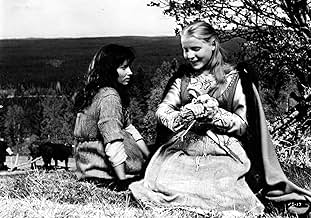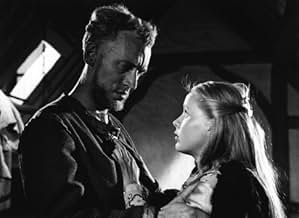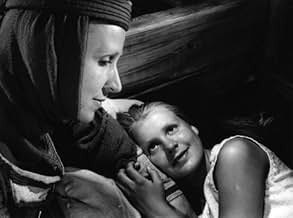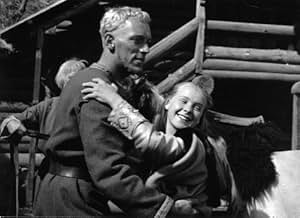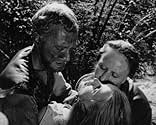अपनी भाषा में प्लॉट जोड़ेंIn 14th-century Sweden, an innocent yet pampered teenage girl and her family's pregnant and jealous servant set out from their farm to deliver candles to church, but only one returns from ev... सभी पढ़ेंIn 14th-century Sweden, an innocent yet pampered teenage girl and her family's pregnant and jealous servant set out from their farm to deliver candles to church, but only one returns from events that transpire in the woods along the way.In 14th-century Sweden, an innocent yet pampered teenage girl and her family's pregnant and jealous servant set out from their farm to deliver candles to church, but only one returns from events that transpire in the woods along the way.
- 1 ऑस्कर जीते
- 6 जीत और कुल 2 नामांकन
- Den gamle drängen
- (बिना क्रेडिट के)
- Den unge drängen
- (बिना क्रेडिट के)
फ़ीचर्ड समीक्षाएं
The luminous Birgitta Pettersson plays Karin, the lovely & virginal daughter of a farming couple (Max von Sydow, Birgitta Valberg). The striking Gunnel Lindblom plays Ingeri, the pregnant wild child whom they've taken in. One day, the two girls set off to transport some candles to church, and the nearest church is a LONG ways away. During the journey, Birgitta makes the acquaintance of two travelling herdsmen (Axel Duberg, Tor Isedal) and their much younger "brother" (Ove Porath). The two young men rape and murder poor Karin, and as luck would have it, they find shelter and food at the nearest abode: the von Sydow and Valberg household. Once the two parents put two and two together, they're ripe for revenge.
Shot in gorgeous black & white by the great Sven Nykvist, "The Virgin Spring" will attract curious viewers if they are like this viewer and are horror fans who have already seen the crude and crass Wes Craven reimagining, "The Last House on the Left". Inevitably, comparisons will be made; while each version is quite memorable in their own way, this film retains the power to shock and depress despite cinema becoming progressively more graphic as the years have gone by.
The performances are excellent. Pettersson is such an appealing presence that it's gut-wrenching what happens to her. Von Sydow is his usual tower of strength as the father who learns that vengeance is not all it's cracked up to be. Duberg and Isedal may not quite make one want to take a bath afterwards the way that Krug and company did in Cravens' film, but they're still sufficiently creepy.
Vivid and credible, this does leave its viewers with some things to think about afterwards, and offers no easy answers.
Inspired by a 13th century Swedish ballad, and scripted by Ulla Isaksson.
Eight out of 10.
The story is deceptively simple and yet filled with harrowing imagery. The assault in the woods is difficult to watch, even in these jaded times, and of course Bergman wrings the maximum tension out of it right from the very beginning. The second half is, perhaps, even more tense, with the expectation of impending violence and the strong, subtle filmmaking techniques (think: lots of lurking shadow, religious iconography, haunted faces). The excellent use of black and white photography reminded me of Kurosawa's work on RASHOMON. Max von Sydow holds it all together as the brusque father and family man, but he heads a cast who can do no wrong.
Wes Craven went for a lurid, contemporary remake in LAST HOUSE ON THE LEFT, but despite the graphic nature of Craven's film I don't think it holds a candle to this one.
**** (out of 4)
Ingmar Bergman's classic (and influential) film about three brothers, two of whom rape and kill a young girl only to end up at the girl's house later that night where her father (Max von Sydow) seeks vengeance. This was my second viewing of this film and it was certainly better this second time even though I loved it on the first viewing. As I said last year, Wes Craven's The Last House on the Left and the Italian shocker House on the Edge of the Park ripped this film off quite heavily and went over the top with graphic violence, gore, nudity and everything else imaginable yet these cheap shock thrills can't hold a candle to this film. This is masterfully directed and contains so much power that very few directors could have pulled it off. The eerie and haunting rape scene is very casual yet contains extreme power. The revenge sequence as well as the conclusion are also very subtle but pack a wonderful punch. I think it was a great choice for these scenes to play out without the use of a music score. This really helps the bitterness and creepiness of the film. A perfect atmosphere and brilliant performances really push this film over the top. von Sydow doesn't say much here but his acting with his eyes and body jesters are priceless.
क्या आपको पता है
- ट्रिवियाThe bridge keeper played by Axel Slangus clearly is supposed to be Odin. Beside his comments about recognizing Ingeri as if they have met before (suggesting he heard her prayer at the beginning of the film), there are several nods to Odinic lore. Before the bridge keeper appears, a raven is seated outside his hut. The raven was considered to be sacred to Odin. When the bridge keeper is finally shown up close, it can be seen that he is one-eyed, which is Odin's most prominent feature, having sacrificed an eye to attain wisdom. Finally, when Ingeri sits in the high-seat, she suddenly has seemingly clairvoyant hearing. This is a nod to Odin's high-seat Hlidskjalf, from which he could see all things happening in the world.
- गूफ़When the Boy Goat Herder is placing dirt on Karin's body, her torso moves even though she is supposed to be dead.
- भाव
Beggar: See the smoke trembling under the roof as if with fright? Yet when it gets out in the air, it has the whole sky to swirl about in. But it doesn't know that, so it huddles and trembles in the soot under the roof. It's the same with people. They quiver like a leaf in the storm, afraid of what they know and what they don't know.
- कनेक्शनEdited into Journal d un père (2023)
टॉप पसंद
विवरण
बॉक्स ऑफ़िस
- दुनिया भर में सकल
- $6,952
- चलने की अवधि1 घंटा 29 मिनट
- रंग
- ध्वनि मिश्रण
- पक्ष अनुपात
- 1.37 : 1
इस पेज में योगदान दें



